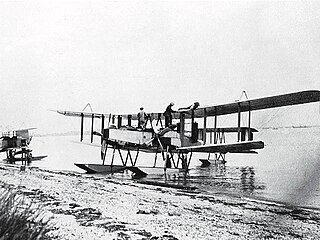Related Research Articles

Between 1911 and 1914, the Royal Aircraft Factory used the F.E.2 designation for three quite different aircraft that shared only a common "Farman" pusher biplane layout.
The Pemberton-Billing P.B.25 was a First World War British single-seat scout aircraft built by Pemberton-Billing Limited, later Supermarine Aviation Works Limited.

The SPAD S.A was a French two-seat tractor biplane first flown in 1915. It was used by France and Russia in the early stages of the First World War in the fighter and reconnaissance roles. It was a unique aircraft that carried its observer in a nacelle ahead of wing, engine and propeller.

The Farman F.50 was a French twin-engined night bomber designed and built by Farman as a replacement for the single-engined Voisin pusher biplanes in service with the French Air Force.

The Gloster TC.33 was a large four-engined biplane designed for troop carrying and medical evacuation in the early 1930s. Only one was built.

The Zeppelin-Staaken Riesenflugzeuge were a series of very large bomber aircraft - Riesenflugzeuge, usually powered by four or more engines, designed and built in Germany from 1915 to 1919.

The Henry Farman HF.30 was a two-seat military biplane designed in France around 1915, which became a principal aircraft of the Imperial Russian Air Service during the First World War. Although it was widely used on the Eastern Front, and by the factions and governments that emerged in the subsequent Russian Civil War, it is not well known outside that context: the HF.30 was not adopted by other Allied air forces, and the manufacturers reused the "Farman F.30" designation for the Farman F.30 in 1917.
The Farman F.30A C2 was a two-seat biplane designed as a fighter in France in 1916 and powered by a single, water-cooled radial engine. It showed poor flight characteristics and only one was built, though it was modified twice. It should not be confused with the similarly named Henry Farman HF.30 of 1915, a completely different aircraft which was used in large numbers by the Imperial Russian Air Service.

The Blackburn G.P seaplane,, was a British twin-engine reconnaissance torpedo floatplane of the First World War, built by the Blackburn Aeroplane and Motor Co Ltd.

The LFG Roland G.I was a large prototype single-engine biplane bomber built in Germany in 1915, during World War I. It had a single engine buried in the fuselage driving pusher configuration propellers mounted on outriggers.

The Siemens-Schuckert L.I was a large, three-engined biplane bomber aircraft, built in Germany towards the end of World War I. It was a twin boom design, strongly influenced by the successful Caproni Ca.3. Three were built but not used operationally.
The Oeffag G , sometimes known as the Oeffag Type G or Oeffag-Mickl G, was a three-engined reconnaissance flying boat built in Austria during the First World War and deployed by the Kaiserlich und Königlich Seefliegerkorps.
The Latham E-5 was a large French Naval four engine biplane flying boat, flown in 1925. It was successfully tested but only one was built.
The Caproni Ca.61 was an Italian heavy day bomber aircraft of 1922. It was the final development of the Caproni three engine, twin boom biplane types developed during World War I, but it was not put into production.
The Caproni Ca.66 was an Italian night bomber designed to reequip the post-World War I Italian Air Force. Only two examples of the four-engined biplane were built.
The Astra 1916 bomber was a large 3-engined biplane, with two fuselages and a central nacelle. Power was supplied by three 220 hp (160 kW) Renault 12Eb water-cooled V-12 piston engines, two tractor engines in the noses of the fuselages and a pusher engine at the rear of the central nacelle. The flight crew of two sat in individual cockpits in the central nacelle and a gunner were housed in a cockpit, aft of the wings, in each fuselage. Designed for a 1916 concours puissant the performance of the aircraft was unsatisfactory and further development was abandoned.
The Audenis C2 was a two-seat fighter biplane, designed and built in France during 1916. Probably powered by a 130 hp (97 kW) Clerget 9B 9-cylinder rotary engine, the C2 had equal span single bay biplane wings with the lower mainplane set well below the fuselage attached by the rear undercarriage struts and a pair of struts at the leading edge. The undercarriage was of conventional tailskid configuration with the mainwheel axle attached to the fuselage by V-struts. Pilot and gunner were seated in individual cockpits with the pilot under the centre-section and the gunner aft of the wings, provided with a single fixed Vickers machine-gun fired by the pilot and a machine-gun on a ring in the rear cockpit. Development of the C2 did not continue after initial flight trials.
The Blériot 73 was a large First World War French heavy night bomber designed and built by Blériot to the BN3 specification. Only a single prototype was built, which crashed on landing from its first flight, killing the pilot. The Blériot 74, Blériot 75 and Blériot 76, respectively, a heavy bomber / airliner, airliner and heavy bomber, directly evolved from the Blériot 71 / Blériot 73 bombers.
The Grigorovich MK-1 was a large trimotor floatplane, built and tested in Imperial Russia in 1916.
The Caproni Ca.66 and Caproni Ca.67 were Italian night bomber aircraft designed to re-equip the post-World War I Regia Aeronautica.
References
- ↑ Davilla, Dr. James J.; Soltan, Arthur M. (January 2002). French aircraft of the First World War. Flying Machines Press. p. 233. ISBN 1891268090.